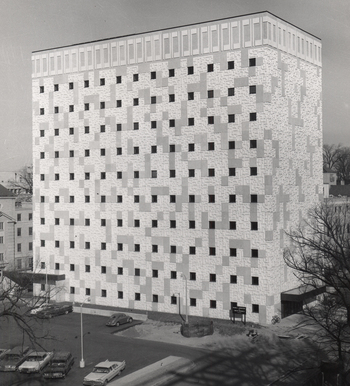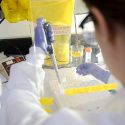Legend in genetics at forefront of book about heroism during 20th century’s darkest hours
Geneticist Waclaw Szybalski, at home in Madison, discusses his wartime experiences. Szybalski played a critical role in a recently published book on heroic scientists in occupied Poland during World War II.
Photo: David Tenenbaum
Waclaw Szybalski, 92, a genius of genetics who has been repeatedly mentioned as a candidate for the Nobel Prize, grew up as an aspiring scientist during World War II in the eastern part of Poland as it suffered brutal occupations by the Soviet Union, Germany, and then the Soviets once again.
In his home city — Lwów, Eastern Poland — Szybalski witnessed German and Soviet atrocities, including the deportation or killing of nearly all Jews and millions of non-Jewish Poles.
An aspiring scientist, many of Szybalski’s most significant wartime roles concerned a decidedly applied type of science: He cooked TNT so the Polish resistance could sabotage rail lines. He participated in smuggling typhus vaccine to Jews in the Warsaw Ghetto. And he fed lice and supervised “louse feeders,” including eminent scientists who found refuge from both occupiers while working in what author Arthur Allen calls the “Fantastic Laboratory of Dr. Weigl.”
While writing a new book of that name, published last month by Norton, Allen relied heavily on the memories and writings of Szybalski, who worked in zoologist Rudolf Weigl’s laboratory during the war and later became a famed University of Wisconsin–Madison geneticist. Weigl invented the first effective vaccine against the dreaded typhus.

Waclaw Szybalski (left) receives the Grand Cross of the Order of Polonia Restituta (Rebirth of Poland) from President Bronislaw Komorowski of Poland (right) in 2011 for his “extraordinary and distinguished service.”
Photo: Foundation Professor Waclaw Szybalski
Allen stumbled on Weigl’s story while researching his earlier book on vaccines, and quickly located Szybalski, who was “primordially important,” Allen says, in writing the new book. Long before they met, the University of Wisconsin–Madison scientist “had done a huge amount of work to research what was going on, gathering witnesses and survivors. I was extremely fortunate to spend some time with him.”
Typhus is a notoriously dangerous bacterial disease that is spread by lice. It can run rampant among soldiers, refugees and concentration camp inmates — a succinct description of wartime Europe.
Weigl was making typhus vaccine in Lwów, and that made him valuable to both the Soviets, who occupied eastern Poland from 1939 to 1941, and the Germans, who occupied all of Poland from 1941 to 1945.
Growing the typhus bacteria required body lice, and they required human blood, so the feeders strapped cages filled with lice to their legs and waited 45 minutes for the arthropods to guzzle their fill of blood. The time passed quickly, Szybalski says, due to the sophisticated, emotional discussion among the mathematicians and scientists seated around the table.
“After I escaped Poland, I was often waking with a nightmare: I’m back there, captured, covered with cold sweat.”
Waclaw Szybalski
Weigl managed to save hundreds of scientists from deportation and death during the Soviet and German occupations, and even succeeded in hiding and protecting several Jews “right at the lab,” Szybalski notes. The Holocaust memorial Yad Vashem posthumously named Weigl as “righteous among the nations” for his heroism.
Szybalski was born in cosmopolitan Lwów (now Lviv, Ukraine), and grew up in a part of Poland that had been salvaged in 1918 from the wreckage of the Austro-Hungarian empire. “My family was Roman Catholic,” he says, “but we went also to other services. There were some friction, but I did not feel Jews were somebody foreign; I was born among them and my two surviving best friends from Lwów (93 and 99 years old) are of Jewish origin.”
The occasional outbreaks of violence, he adds, were “something I would notice in a newspaper, but it was nothing that touched me before the war. With the Russian invasion, everything became upended.”
A geneticist who entered the field even before the structure of DNA was discovered in 1953, Szybalski talked his way into the United States in 1950 and had made his name in genetics even before he reached UW–Madison in 1960.

In 1960, Szybalski started at UW–Madison’s McArdle Laboratory, pictured above in 1965, and quickly established himself as a renowned geneticist.
Photo: UW Archives
In 1960, Szybalski joined the McArdle Laboratory at UW–Madison and started pioneering studies on a virus that infects bacteria, which became a mainstay in his career-long interest in the transfer, modification and regulation of genes.
In 1962, Szybalski was the first to insert DNA into human cells, and in 1963, he was the first to create functional DNA in a glass dish. Szybalski’s technique for separating those cells that had been genetically modified laid the groundwork for the monoclonal antibody, which won the Nobel Prize. He is now an emeritus professor of oncology in the UW School of Medicine and Public Health.
Insight, combined with persistence, is a Szybalski hallmark, said former postdoctoral student Frederick Blattner, an emeritus professor of genetics at UW–Madison. “He’s a poet of the scientific method, able to speculate, to develop tests and hypotheses; he had an uncanny way of unraveling complex problems.”
But growing up under two of the most savage and evil empires of the 20th century left a mark, Szybalski says. “After I escaped Poland, I was often waking with a nightmare: I’m back there, captured, covered with cold sweat. Under these tyrannies, you never knew what would happen at night or the next day.”
When people asked why he was not praying, he told them, “‘I might not die, so why should I pray?’ I was so optimistic during the war, and I’m still optimistic.”
Referring to those perilous times, Szybalski says, “My secret was good luck and an instinct not to be at the wrong place at the wrong time. I was a boy scout, and I learned to survive both in the forest and in the city.”
The Germans were staging arrests and deportation “actions” that lasted for a few days. “If you were not caught, killed or deported, you were saved until the next action. I was fighting, never giving up. I would either escape, run or hide. The Germans would close each end of the street and take everybody to a labor or concentration camp, whatever the spirit moved them. But on each block, I knew places to escape into neighboring blocks.”
Szybalski remains bitter about some Allied decisions. At considerable risk, he secretly mapped and photographed rail lines that Germans used to transport Jews from Lwów to labor and death camps, like Belzec, so American bombers could destroy the key railroad junctions, but those Allied bombers never arrived. “I made the plans, but Mr. Roosevelt did not like them, so all my effort went for nothing,” he says.
That acid wit is characteristic. In 1939, he notes, “in a very neat pact, Hitler and Stalin divided Poland practically 50-50,” but then the bitterness comes to the surface. “The 50 percent grabbed by Stalin were never returned to Poland, as per the evil and shameful Yalta Agreement, while the Polish population was ethnically cleaned in 1945-47 by Stalin’s henchmen.”
Szybalski looked back on the horrors and disappointments and said simply, “I hope they would not be repeated, but we are still having a lot of cruelty all over the world.”
Still, the bitterness coexists with an optimist. Even during the war, he says, “We thought in another ‘three months’ we would be free; we thought the war and occupations were temporary, but for Poland they lasted from 1939 until 1989, a half century.”
During the war, he says, his studies and lab work kept him busy. “I did not have time to worry. I knew it was only temporary, and I had to prepare for the next part of my life.” During bombardments of 1939, ’41, ’44 and ’45, “people were sitting in cellars, the whole house was jumping, and they were praying. I was in some corner with an English-Polish technical dictionary, learning English.” When people asked why he was not praying, he told them, “‘I might not die, so why should I pray?’ I was so optimistic during the war, and I’m still optimistic.”
As he prepared to attend the 2014 meeting of a genetic group he helped found 65 years ago, which focuses on bacteria-infecting viruses, Szybalski looked back on the horrors and disappointments and said simply, “I hope they would not be repeated, but we are still having a lot of cruelty all over the world. Presumably civilized people are killing each other in 2014! There is always a good excuse for it, but it’s still killing.”



